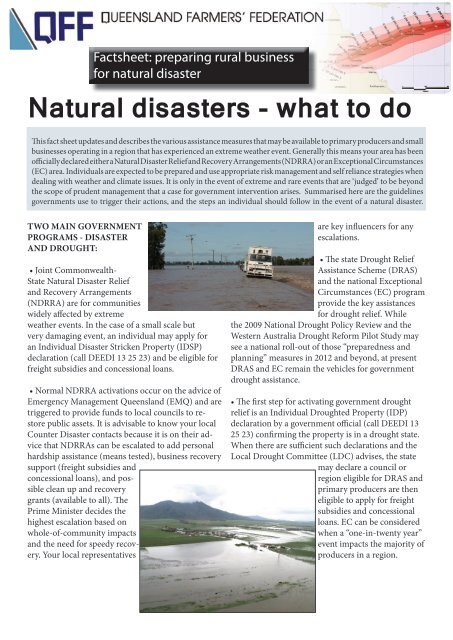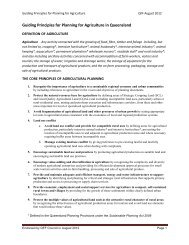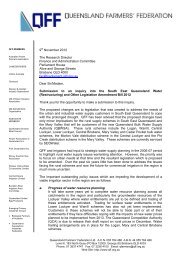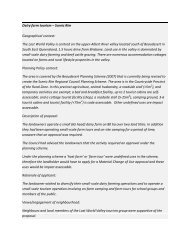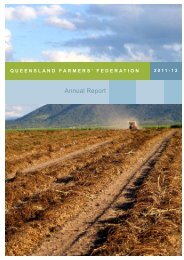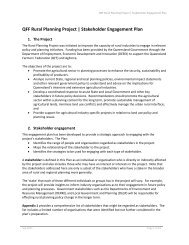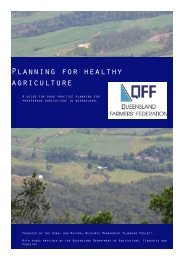Disaster assistance fact sheet - Queensland Farmers Federation
Disaster assistance fact sheet - Queensland Farmers Federation
Disaster assistance fact sheet - Queensland Farmers Federation
You also want an ePaper? Increase the reach of your titles
YUMPU automatically turns print PDFs into web optimized ePapers that Google loves.
Fact<strong>sheet</strong>: preparing rural businessfor natural disasterNatural disasters - what to doThis <strong>fact</strong> <strong>sheet</strong> updates and describes the various <strong>assistance</strong> measures that may be available to primary producers and smallbusinesses operating in a region that has experienced an extreme weather event. Generally this means your area has beenofficially declared either a Natural <strong>Disaster</strong> Relief and Recovery Arrangements (NDRRA) or an Exceptional Circumstances(EC) area. Individuals are expected to be prepared and use appropriate risk management and self reliance strategies whendealing with weather and climate issues. It is only in the event of extreme and rare events that are ‘judged’ to be beyondthe scope of prudent management that a case for government intervention arises. Summarised here are the guidelinesgovernments use to trigger their actions, and the steps an individual should follow in the event of a natural disaster.TWO MAIN GOVERNMENTPROGRAMS - DISASTERAND DROUGHT:• Joint Commonwealth-State Natural <strong>Disaster</strong> Reliefand Recovery Arrangements(NDRRA) are for communitieswidely affected by extremeweather events. In the case of a small scale butvery damaging event, an individual may apply foran Individual <strong>Disaster</strong> Stricken Property (IDSP)declaration (call DEEDI 13 25 23) and be eligible forfreight subsidies and concessional loans.• Normal NDRRA activations occur on the advice ofEmergency Management <strong>Queensland</strong> (EMQ) and aretriggered to provide funds to local councils to restorepublic assets. It is advisable to know your localCounter <strong>Disaster</strong> contacts because it is on their advicethat NDRRAs can be escalated to add personalhardship <strong>assistance</strong> (means tested), business recoverysupport (freight subsidies andconcessional loans), and possibleclean up and recoverygrants (available to all). ThePrime Minister decides thehighest escalation based onwhole-of-community impactsand the need for speedy recovery.Your local representativesare key influencers for anyescalations.• The state Drought ReliefAssistance Scheme (DRAS)and the national ExceptionalCircumstances (EC) programprovide the key <strong>assistance</strong>sfor drought relief. Whilethe 2009 National Drought Policy Review and theWestern Australia Drought Reform Pilot Study maysee a national roll-out of those “preparedness andplanning” measures in 2012 and beyond, at presentDRAS and EC remain the vehicles for governmentdrought <strong>assistance</strong>.• The first step for activating government droughtrelief is an Individual Droughted Property (IDP)declaration by a government official (call DEEDI 1325 23) confirming the property is in a drought state.When there are sufficient such declarations and theLocal Drought Committee (LDC) advises, the statemay declare a council orregion eligible for DRAS andprimary producers are theneligible to apply for freightsubsidies and concessionalloans. EC can be consideredwhen a “one-in-twenty year”event impacts the majority ofproducers in a region.
Fact<strong>sheet</strong> (page 2): preparing ruralbusiness for natural disasterSome steps you can takeBe Community Aware. While it is noted above that the<strong>Queensland</strong> government may provide special <strong>assistance</strong>for primary producers severely impacted by an extremeclimate event through either the IDP (drought) or IDSP(disaster) declaration, it is when the scope and scale ofthe event reaches a point that may have community wideimpacts (combination of health, community services,infrastructure and business activity) that state andfederal funds become available. The priority is to restorepublic assets (roads, schools, hospitals, etc), but if thereis widespread damage to private property then personalhardship grants may be available (usually means tested),the primary producer and small business package maybe activated, and in extreme cases clean up and recoverygrants may be made available to anyone impacted by theevent (conditions may apply depending on the event).If a Flood, Storm or Cyclone comes your way. AsideExceptional CircumstancesExceptional Circumstances (EC) occur when a rare (onein twenty or more years) and severe event (scope andscale is significant) causes a prolonged (more than oneyear) downturn in income for a significant proportion ofthe farm businesses in a region, and is unable to be managedusing normal risk management practices. EC eventsrequire initial assessments by industry and state officials,then a formal submission to the Australian governmentfor assessment by the National Rural Advisory Council.If granted, EC <strong>assistance</strong> provides a range of measures toassist affected farmers, rural communities and small businessesincluding income support, interest rate subsidiesand free counselling. Should an EC event be declared inthe next year a special EC Fact Sheet will detail the <strong>assistance</strong>measures being offered at that time. Backgroundinformation is available atwww.daff.gov.au/agriculture-food/drought/ec1. Individual property declaration for severe damage–Call DEEDI 13 25 23 – if confirmed, the declaration providesfreight subsidies for up to $5,000 and concessionalloans to $250,000 on a demonstrated needs basis.2. Area NDRRA declared – Initial declarationusually covers only public assets and counter disasteroperations. Your local council is the best source ofadvice.from the above, make sure you have noted down whomyour Emergency Services and Counter <strong>Disaster</strong> contactsare for your local area. Also, we suggest you subscribe toany relevant “Alerts” program available in your region.Know your way around the Bureau of Meteorology website and those of the providers of your utility services (gas,electricity and water);www.bom.gov.auwww.abc.net.au3. NDRRA extended - Emergency Services <strong>Queensland</strong>identifies wider impacts and activates personal hardshiprelief and business support measures. Call QRAA 1800623 946 or DEEDI for advice and application forms.4. NDRRA extended to highest level – more <strong>assistance</strong>sbecome available to maximise clean up and recovery efforts(amount and form can vary). Call QRAA 1800 623946 and Centrelink 13 23 16 for application advice.Two useful websites that are usually current are;www.qraa.qld.gov.auwww.emergency.qld.gov.au


